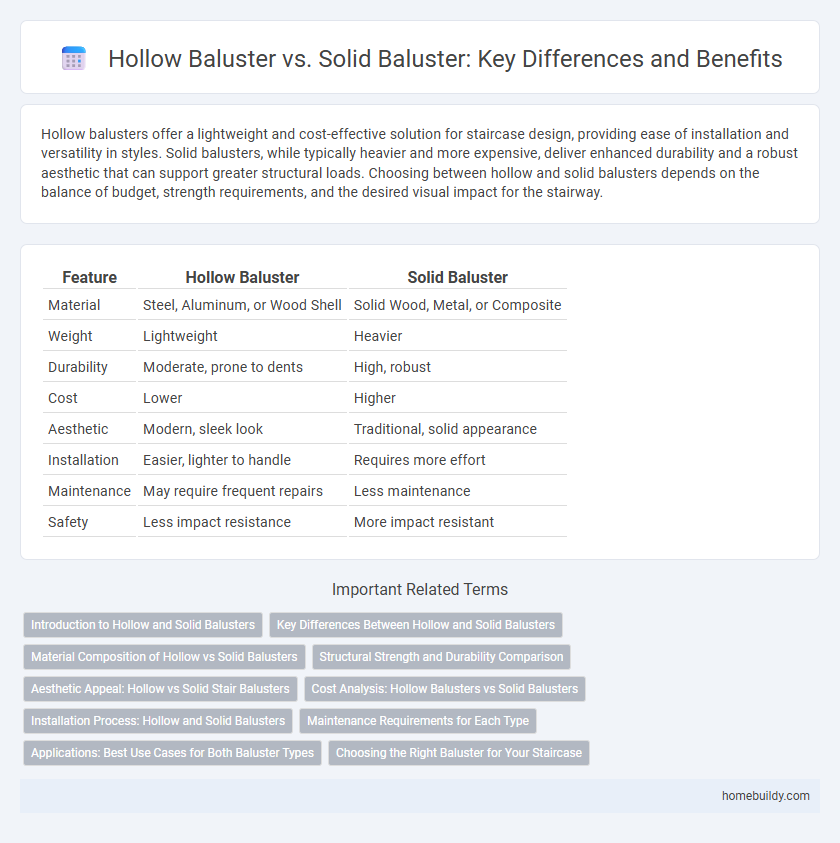Hollow balusters offer a lightweight and cost-effective solution for staircase design, providing ease of installation and versatility in styles. Solid balusters, while typically heavier and more expensive, deliver enhanced durability and a robust aesthetic that can support greater structural loads. Choosing between hollow and solid balusters depends on the balance of budget, strength requirements, and the desired visual impact for the stairway.
Table of Comparison
| Feature | Hollow Baluster | Solid Baluster |
|---|---|---|
| Material | Steel, Aluminum, or Wood Shell | Solid Wood, Metal, or Composite |
| Weight | Lightweight | Heavier |
| Durability | Moderate, prone to dents | High, robust |
| Cost | Lower | Higher |
| Aesthetic | Modern, sleek look | Traditional, solid appearance |
| Installation | Easier, lighter to handle | Requires more effort |
| Maintenance | May require frequent repairs | Less maintenance |
| Safety | Less impact resistance | More impact resistant |
Introduction to Hollow and Solid Balusters
Hollow balusters are typically made from lightweight materials like aluminum or vinyl, offering cost-effective durability and easier installation compared to solid balusters. Solid balusters, often crafted from hardwood or wrought iron, provide superior strength and a classic aesthetic but come with increased weight and higher price points. Choosing between hollow and solid balusters depends on factors such as budget, desired style, structural requirements, and maintenance preferences in stair railing design.
Key Differences Between Hollow and Solid Balusters
Hollow balusters are lightweight, cost-effective, and easier to install, making them ideal for large projects or budget-conscious renovations, whereas solid balusters offer superior strength, durability, and a more substantial aesthetic appearance. Solid balusters typically require less maintenance over time due to their resistance to bending or breaking, while hollow balusters may be prone to dents and damage under heavy impact. Material choice also influences performance, with solid wood or metal balusters providing enhanced structural support compared to their hollow counterparts made from aluminum or PVC.
Material Composition of Hollow vs Solid Balusters
Hollow balusters are typically constructed from lightweight metals such as aluminum or steel, or from engineered materials like PVC, offering corrosion resistance and ease of installation. Solid balusters are commonly made from dense hardwoods, steel, or wrought iron, providing greater structural strength and durability. The choice of material composition affects the baluster's load-bearing capacity, maintenance requirements, and aesthetic appeal in stair railing systems.
Structural Strength and Durability Comparison
Solid stair balusters offer superior structural strength and durability compared to hollow balusters due to their dense material composition, making them more resistant to impact and wear over time. Hollow balusters, while lighter and often more cost-effective, can be prone to bending or denting under heavy loads or frequent use. Choosing solid balusters ensures long-term stability and safety in staircase construction, especially in high-traffic areas.
Aesthetic Appeal: Hollow vs Solid Stair Balusters
Hollow balusters offer a sleek and modern aesthetic with their lightweight design and often intricate patterns, enhancing openness and light flow along staircases. Solid balusters provide a robust, traditional look that emphasizes durability and detailed craftsmanship, creating a strong visual impact. Choosing between hollow and solid balusters depends on desired style, with hollow favoring contemporary elegance and solid emphasizing classic sophistication.
Cost Analysis: Hollow Balusters vs Solid Balusters
Hollow balusters typically cost less due to reduced material usage, making them a budget-friendly option for large-scale stair projects. Solid balusters provide greater durability and strength, often justifying their higher price through enhanced longevity and premium appearance. Choosing between hollow and solid balusters depends on balancing upfront costs with long-term value and maintenance considerations.
Installation Process: Hollow and Solid Balusters
Hollow balusters are lighter and easier to handle during installation, often requiring only screws or adhesives for secure attachment, which speeds up the process and reduces labor costs. Solid balusters, being heavier and denser, typically need pre-drilling and more precise alignment to ensure stability and durability, making their installation more time-consuming and labor-intensive. Both types demand careful measurement and alignment to maintain safety standards and aesthetic consistency in stair design.
Maintenance Requirements for Each Type
Hollow balusters require periodic inspection for dents, corrosion, or cracks due to their thin walls, and may need repainting or rust treatment to prevent deterioration, especially in metal variants. Solid balusters offer greater durability with minimal maintenance, typically only needing occasional cleaning and touch-ups on finish, making them more resistant to physical damage and environmental wear. Choosing solid balusters reduces long-term upkeep costs and ensures structural integrity in high-traffic or exposed staircases.
Applications: Best Use Cases for Both Baluster Types
Hollow balusters are ideal for residential staircases where lightweight materials simplify installation and reduce costs, commonly found in modern or contemporary interior designs. Solid balusters provide superior strength and durability, making them best suited for high-traffic commercial spaces or staircases requiring extra support and long-term resilience. Both types can be crafted from materials like wood, metal, or composite, allowing tailored use based on aesthetic preferences and structural requirements.
Choosing the Right Baluster for Your Staircase
Choosing the right baluster for your staircase involves comparing hollow balusters, which offer a lighter weight and are often more cost-effective, with solid balusters that provide superior strength and durability. Hollow balusters work well in modern designs where aesthetic flexibility and ease of installation are priorities, while solid balusters are ideal for traditional or heavy-traffic staircases requiring enhanced support. Evaluating factors such as material, maintenance, and design preferences helps determine whether hollow or solid balusters best suit your staircase's structural and decorative needs.
hollow baluster vs solid baluster Infographic

 homebuildy.com
homebuildy.com